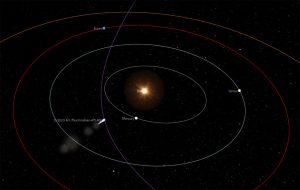Skyscape: A bright comet will be visible to the naked eye in the sky this week, and may be visible in daylight from mid-October. Comet C/2023 A3 is currently visible on the southeastern horizon shortly before sunrise and is impressive with its powerful dust tail. On September 27, 2024, C/2023 A3 will reach its closest point to the Sun in its nearly 80,000-year orbit, and on October 13, it will reach its closest point to Earth. It may then outshine Venus in brightness.
Whether it's Leonard, NEOWISE or Halley's Comet: comets come so close to Earth that they can be seen in the sky with the naked eye. The origin of these “dusty ice balls” lies in the vast Kuiper Belt and the Oort Cloud. But as they approach the Sun on their elongated, eccentric and usually inclined orbits, solar radiation heats them up and they become active: their bright, often green coma and long tails are formed.

A comet with a particularly dense dust tail.
Now we can marvel at one of these bright comets in the sky again. Comet C/2023 A3 (Tuchinshan-ATLAS) was only discovered in January 2023, when the supposed asteroid began to form its tail. Telescopic observations revealed that this long-period comet’s orbit is nearly perpendicular to the plane of the planet. The object takes about 80,000 years to complete one orbit and orbits the Sun retrogradely—upside down relative to the planets and the Sun’s rotation.
Another feature: Comet C/2023 A3 appears to kick up a lot of dust as it approaches the Sun. This makes its dust tail particularly strong—stronger than the more obvious tail of ionized gas molecules. As a result, Comet ATLAS’s tail reflects a lot of light and appears bright in return.
Only visible in the morning, then in the evening.
From now on, Comet C/2023 A3 will be visible to us in the Northern Hemisphere for the first time. It will appear early this week, about half an hour before sunrise. It will then be visible low above the southeast horizon, below the constellation Sextant — and perhaps even with the naked eye. On September 27, 2024, the comet will make its closest approach to the Sun, passing close to our star at about the altitude of the orbit of Mercury. From the end of this week, C/2023 A3 will be invisible for a few days and will be outshine the Sun.
The comet will be visible again from October 13 when it passes closest to Earth. It will then fly past our planet at a distance of about 70 million kilometers. It is difficult to predict how bright it will be, but astronomers estimate that it will also be visible to the naked eye. C/2023 A3 will then be on the western horizon at dusk.
Source: NASA, Sky Life
September 24, 2024 – Nadia Podpregar






More Stories
Exploding Fireball: Find the meteorite fragments
Neuralink's competitor lets blind people see again with an implant
A huge meteorite has hit Earth – four times the size of Mount Everest